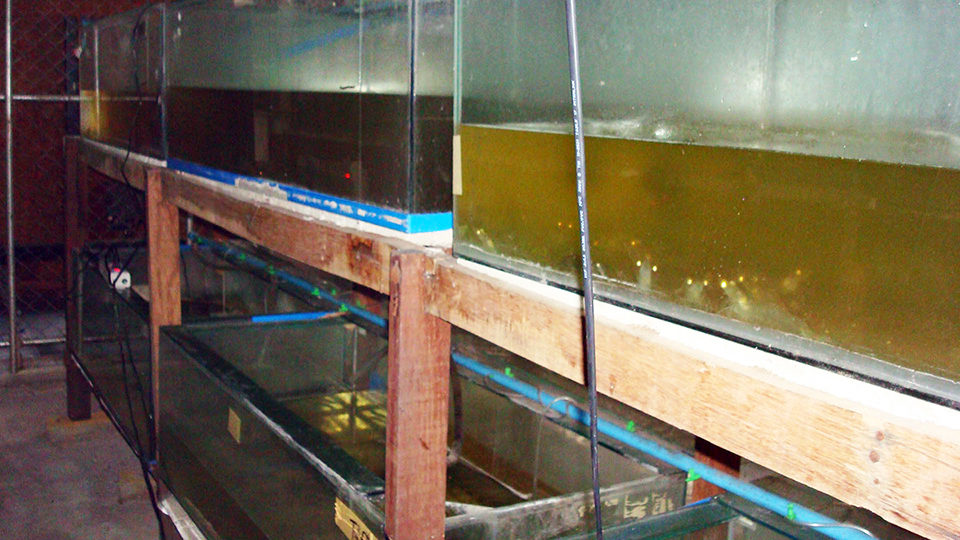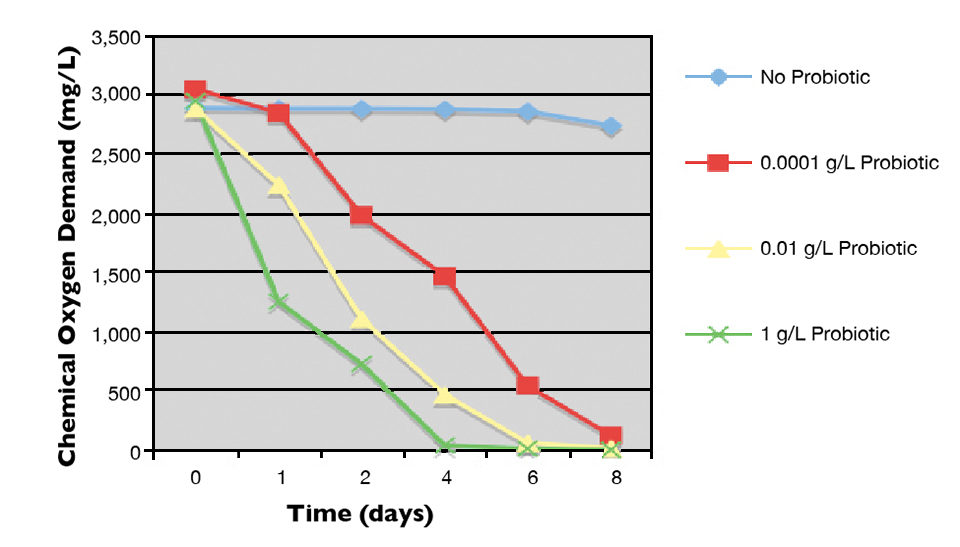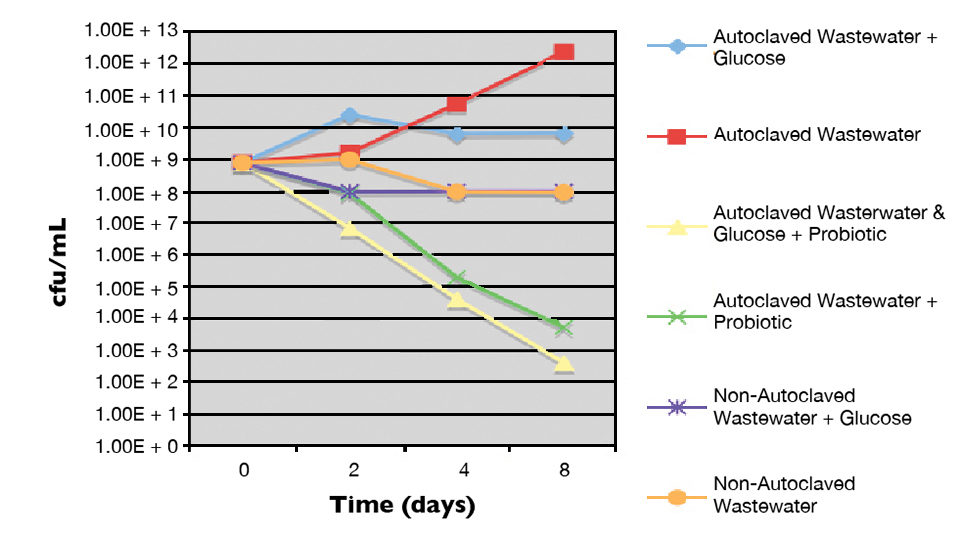Science on effects of bacterial amendments not definitive

The use of bacterial amendments has become an accepted practice in commercial shrimp farming worldwide. Products containing selected strains of bacteria are marketed as “probiotics,” which when added to ponds are said to improve water quality and pond bottom conditions while reducing pathogenic microbes. The widespread use of these products by an industry with declining profit margins is evidence of positive grower perceptions toward the use of probiotic blends in pond ecosystems.
There are many probiotic products on the market which range in price and quality. Some have followed meticulous quality control systems and are based on years of scientific research. Unfortunately, the market also has low-quality products that offer growers little to no value. These products can cast doubt on the use of microbial amendments in aquaculture.
Controlled methods needed
The scientific literature on the effects of bacterial amendments in pond systems is not definitive, and as a result, opinions among experts in the field vary. Many research papers have shown the value of probiotic effects on bacterial flora and water quality parameters in ponds. These types of products are widely used in wastewater treatment industries and for specialty remediation.
The principles behind the manipulation of microbial communities through competitive exclusion and for direct effects on waste degradation are well known. On the other hand, the inherent variability of aquaculture pond systems, the cost and complexity of running well-replicated studies and the difficulty in maintaining proper controls in a production environment have hampered the ability of scientists to clearly demonstrate effects in the field.
A better understanding of comparative efficacy and modes of action of various probiotic products will depend upon the development of more controlled laboratory testing models. The authors recently developed methods to objectively characterize and document the activity of MERATM Bac W, a commercial probiotic from Novus International.
Initial water quality evaluation
An initial evaluation of any probiotic should focus on in-vitro microbiology laboratory assessments. U.S. Food and Drug Administration Bacteriological Analytical Manual and Association of Analytical Communities procedures were used to verify bacterial populations in the product on the order of 1 billion/g. Disc diffusion methods and broth inhibition assays were used to confirm inhibition rates against pathogens of interest, including Vibrio harveyii.
Next, a trial was developed at the Department of Aquaculture, Faculty of Fisheries, Kasetsart University in Bangkok, Thailand. A series of 120-L glass aquariums were filled with water from a shrimp pond to evaluate the effects of probiotics on water quality variables. Ten shrimp weighing about 10 g each were stocked in each aquarium and fed a 32 percent-protein diet at 2 percent body weight/day. The aquariums were managed without probiotic treatment or with one or two weekly applications. All treatments were run with five replicates.
Application rates were calculated based on the recommended pond dosage of 1 kg/1,600 m3. Water quality variables were measured every three days to evaluate the efficiency of the bacterial amendment activity. Total phosphorus was also measured weekly. Systems were maintained for the two-week test with no water exchange.
Shrimp survival was high in all treatments. The replicated aquarium system allowed comparisons of means between treatments for all water quality parameters. For every parameter measured, water quality in the treatments receiving probiotic was improved relative to the control over the course of the study (Table 1).
Browdy,Efficiency of the tested probiotic, Table 1
| Parameter | Weekly Probiotic Applications | Decrease Relative to Control Without Probiotic (%) Day 3 | Decrease Relative to Control Without Probiotic (%) Day 7 | Decrease Relative to Control Without Probiotic (%) Day 10 | Decrease Relative to Control Without Probiotic (%) Day 14 |
|---|---|---|---|---|---|
| Total suspended solids | 1 | 6.0 ± 2.6 | 14.5 ± 3.7 | 13.4 ± 2.6 | 13.7 ± 2.6 |
| Total suspended solids | 2 | 9.9 ± 3.7 | 20.2 ± 2.5 | 20.1 ± 1.9 | 24.4 ± 3.1 |
| Ammonia nitrogen | 1 | 27.6 ± 8.6 | 35.3 ± 4.3 | 30.4 ± 5.4 | 37.2 ± 2.4 |
| Ammonia nitrogen | 2 | 35.9 ± 6.5 | 32.8 ± 3.3 | 40.8 ± 3.5 | 39.1 ± 3.6 |
| Nitrite nitrogen | 1 | 5.7 ± 4.0 | 6.3 ± 4.3 | 5.6 ± 3.3 | 13.8 ± 3.0 |
| Nitrite nitrogen | 2 | 12.3 ± 2.8 | 11.1 ± 2.8 | 11.2 ± 3.7 | 17.8 ± 3.8 |
| Nitrite nitrogen | 1 | 1.5 ± 6.7 | 10.5 ± 2.4 | 14.0 ± 2.9 | 7.8 ± 3.0 |
| Nitrite nitrogen | 2 | 9.4 ± 3.7 | 18.8 ± 3.3 | 26.1 ± 4.3 | 17.9 ± 4.8 |
| Organic nitrogen | 1 | 13.6 ± 8.6 | 14.3 ± 16.4 | 33.2 ± 7.1 | 51.6 ± 23.5 |
| Organic nitrogen | 2 | 14.9 ± 8.7 | 26.3 ± 6.1 | 33.9 ± 6.8 | 52.9 ± 8.7 |
| Biochemical oxygen demand | 1 | 2.5 ± 5.2 | 0.02 ± 4.2 | 44.3 ± 2.7 | 37.51 |
| Biochemical oxygen demand | 2 | 1.3 ± 3.5 | 26.5 ± 7.7 | 54.1 ± 3.2 | 57.7 ± 3.0 |
| Phosphorus | 1 | 9.2 ± 3.4 | 16.7 ± 7.1 | ||
| Phosphorus | 2 | 16.0 ± 2.3 | 30.5 ± 1.5 |
The differences in absolute values on day 14 documented the reductions in metabolites over time. The total suspended solids were reduced from 67.4 ± 1.8 mg/L in the control to 58.2 ± 1.7 and 51.0 ± 2.1 mg/L in the treatments with probiotic applied once and twice weekly, respectively. The total ammonia nitrogen values were reduced from 0.95 ± 0.1 mg/L in the control to 0.59 ± 0.02 and 0.57 ± 0.03 mg/L in treatments with probiotic applications once and twice per week.
The differences in total nitrite nitrogen and nitrate nitrogen were limited, but clear trends toward lower values were apparent with use of the probiotic. The biochemical oxygen demand, which responds to the organic matter concentration, dropped from 40.9 ± 1.8 mg/L in the control to 25.6 ± 1.7 and 17.3 ± 2.1 mg/L in the once- and twice-weekly probiotic treatments.
The total organic nitrogen was reduced from the 1.44 ± 0.14 mg/L control value to 0.7 ± 0.34 and 0.68 ± 0.13 mg/L in treatments with probiotic application once and twice per week, respectively. Overall, this simple aquarium study demonstrated clear improvements in water quality similar to those reported in pond applications.
Effects on water quality, Vibrio harveyii
Another series of studies was carried out in the laboratory of the Department of Biological Sciences at Nicholls State University in Louisiana, USA. The objective of these studies was to develop a small-scale bench-top assay system for testing the effects of the bacterial amendment on water quality and abundance of the shrimp pathogen V. harveyii under controlled conditions.
Replicated 500-ml aerated reactors were incubated with 250 ml of wastewater consisting of previously frozen shrimp sludge collected from a settling tank attached to an intensive shrimp production system. Digestion of autoclaved and non-autoclaved shrimp wastewater, as well as carbon- and nitrogen-rich synthetic wastewater was analyzed with and without supplemental bacterial additions. The carbon in the wastewater was analyzed in the form of chemical oxygen demand (COD), which ranged 2,800 to 3,300 mg/L.
The results indicated the bacterial additions enhanced the rate of organic waste digestion significantly compared to native bacteria (Fig. 1). The rate of waste digestion varied among the probiotic concentrations tested. The highest probiotic concentration of 1 g/L digested all of the organic carbon within four days, while the lowest concentration of 0.0001 g/L achieved removal within eight days.

These differences among various concentrations were statistically significant. Moreover, the complete removal of waste chemical oxygen demand within eight days at recommended concentrations for pond application is a very important finding, particularly considering the fact that most growers treat ponds weekly to assure continual enhancement of waste digestion.
Of interest was the lack of significant change in digestion rates with the addition of glucose. This suggested that despite the high nitrogen content of the shrimp waste tested, addition of labile carbon did not change sludge digestion rates. Further research using this model system could help determine if and when use of supplementary molasses can improve probiotic activity in pond systems.
Vibrio harveyii effects
A second objective of this study was to test the survival effect on the population size of a known shrimp pathogen, V. harveyii, in the presence and absence of bacterial amendments in the wastewater (Figure 2). At the beginning of the experiment, 109 V. harveyii was added to all waste reactors.

The Vibrio survival population was monitored throughout the experiment. V. harveyii counts dropped significantly from 109 to 102 cells/ml in the probiotic-treated reactor within eight days. In the control, 109 V. harveyii was maintained throughout the duration of the experiment. In the autoclaved shrimp waste with V. harveyii, the population of V. harveyii increased to 1012 cells/ml.
This study showed that the supplemental heterotrophic bacterial amendments had a competitive edge over V. harveyii and thus decreased the population of Vibrio. It is interesting to note that Vibrio proliferated in the absence of other heterotrophic bacteria in autoclaved wastewater. Only the selected bacterial strains in the probiotic tested were effective in significantly reducing the Vibrio concentration in the wastewater.
(Editor’s Note: This article was originally published in the January/February 2010 print edition of the Global Aquaculture Advocate.)
Authors
-
Craig L. Browdy, Ph.D.
Novus International Inc.
20 Research Park Drive
St. Charles, Missouri 63304 USA[109,111,99,46,116,110,105,115,117,118,111,110,64,121,100,119,111,114,98,46,103,105,97,114,99]
-
Jesus Venero, Ph.D.
Farshad Shishehchian, Ph.D.
Novus International Inc. -
Orapint Jintasataporn, Ph.D.
Kasetsart University
Bangkok, Thailand -
Prathak Tabthipwon, Ph.D.
Kasetsart University
Bangkok, Thailand -
Oratai Triwutanon, Ph.D.
Kasetsart University
Bangkok, Thailand -
Sara Shields
Nicholls State University
Department of Biological Sciences
Thibodaux, Louisiana, USA -
Raj Boopathy, Ph.D.
Nicholls State University
Department of Biological Sciences
Thibodaux, Louisiana, USA
Tagged With
Related Posts

Health & Welfare
Assessment of supplemental Bacillus probiotics in whiteleg shrimp juveniles
Results of a feeding study supplementing probiotics in the diet showed that when the Bacillus species were complemented in an appropriate concentration into feeds, the growth and feed efficiency of whiteleg shrimp could be improved.

Health & Welfare
Bacillus probiotics benefit tilapia rearing under challenging conditions in Brazil
A recent study that evaluated the benefits of using probiotics with a balanced mixture of Bacillus bacteria strains to inhibit pathogenic bacteria in tilapia.

Health & Welfare
Bacillus probiotics improve hatchery, nursery production in EMS-hit Mexico
In early 2014, a trial to evaluate the effects of a mixture of Bacillus strains on early mortality syndrome bacteria during the larviculture and nursery phases for shrimp was carried out at a commercial hatchery in Mexico.

Health & Welfare
A holistic management approach to EMS
Early Mortality Syndrome has devastated farmed shrimp in Asia and Latin America. With better understanding of the pathogen and the development and improvement of novel strategies, shrimp farmers are now able to better manage the disease.


